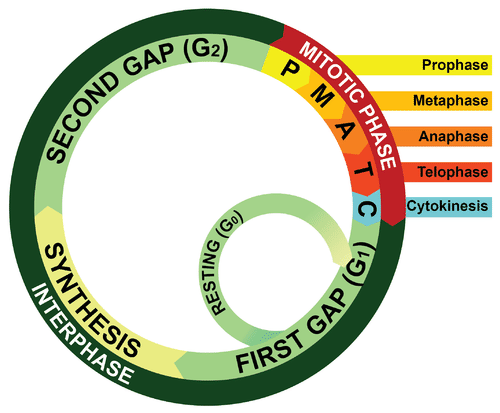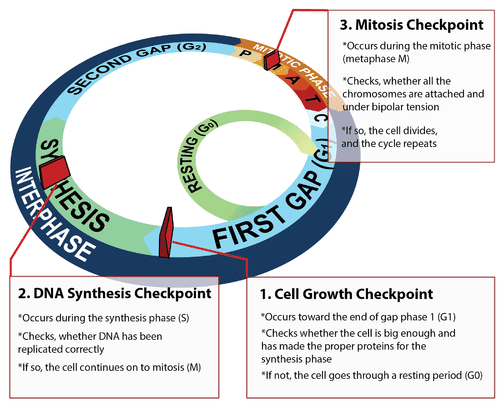7.2 The Cell Cycle
The continuity of life from one cell to another has its foundation in the reproduction of cells by way of the cell cycle. The cell cycle is a repeating series of events that includes growth, DNA synthesis, and cell division. The cell cycle in prokaryotes is quite simple: the cell grows, its DNA replicates, and the cell divides. In eukaryotes, the cell cycle is more complicated.
The eukaryotic cell cycle has several phases. The mitotic phase (M) includes both mitosis and cytokinesis. This is when the nucleus and then the cytoplasm divide. The other three phases (G1, S, and G2) are generally grouped together as interphase. During interphase, the cell grows, performs routine life processes, and prepares to divide.

Interphase
The interphase of the eukaryotic cell cycle can be subdivided into the three phases:
- Gap 1 (G1): During this phase, the cell grows rapidly while performing routine metabolic processes. It also makes proteins needed for DNA replication and copies some organelles in preparation for cell division. A cell typically spends most of its life in this phase.
- Synthesis Phase (S): During this phase, the cell’s DNA is copied in the process of DNA replication to prepare for the upcoming mitotic phase.
- Gap 2 (G2): During this phase, the cell makes final preparations to divide. For example, it makes additional proteins and organelles.
Not all cells adhere to the classic cell-cycle pattern in which a newly formed daughter cell immediately enters interphase, closely followed by the mitotic phase. Cells in the G0 phase are inactive, having exited the cell cycle. Some cells enter G0 temporarily until an external signal triggers the onset of G1. Other cells that never or rarely divide, such as mature cardiac muscle and nerve cells, remain in G0 permanently.
Control of the Cell Cycle
If the cell cycle occurred without regulation, cells might go from one phase to the next before they were ready. What controls the cell cycle? How does the cell know when to grow, synthesize DNA, and divide? The cell cycle is controlled mainly by regulatory proteins. These proteins control the cycle by signalling the cell to either start or delay the cycle’s next phase. They ensure that the cell completes the previous phase before moving on. Regulatory proteins control the cell cycle at key checkpoints.

Figure 7.2.2 Description
The image is a diagram of the cell cycle, illustrating the different phases of cell growth and division, along with key checkpoints that regulate the process.
Description: Circular Representation of the Cell Cycle:
The cycle is divided into distinct phases: Interphase (G1, S, G2) and Mitosis (M).
Interphase includes:
- First Gap (G1) – Cell growth phase.
- Synthesis (S) – DNA replication occurs.
- Second Gap (G2) – Preparation for mitosis.
- The Mitotic Phase (M) represents cell division.
- A Resting Phase (G0) is also indicated for cells that do not proceed with division.
Checkpoints in the Cell Cycle:
- Cell Growth Checkpoint (G1 Checkpoint): Occurs at the end of the G1 phase. Checks if the cell has grown sufficiently and has the necessary proteins for DNA synthesis. If conditions are not met, the cell enters G0 (resting phase).
- DNA Synthesis Checkpoint (G2 Checkpoint): Occurs during the S phase. Ensures that DNA has been replicated correctly before proceeding to mitosis.
- Mitosis Checkpoint (Metaphase Checkpoint): Occurs during the M phase. Checks whether chromosomes are properly attached to the mitotic spindle before cell division continues.
Checkpoints in the eukaryotic cell cycle ensure the cell is ready to proceed before it moves on to the next phase.
- Cell Growth Checkpoint – Occurs in G1 just before entry into the S phase, decides whether the cell should divide.
- DNA Synthesis Checkpoint – Determines if the DNA has been replicated properly.
- Mitosis Checkpoint – Occurs during metaphase and ensures that all the chromosomes are properly aligned before the cell is allowed to divide.
Cancer and the Cell Cycle
Cancer is a disease that occurs when the cell cycle is no longer regulated. This happens because a cell’s DNA becomes damaged. Damage can occur due to exposure to hazards, such as radiation or toxic chemicals. Cancerous cells generally divide much faster than normal cells, which may end up forming a mass of abnormal cells called a tumour (see Figure 7.2.3). The rapidly dividing cells take up nutrients and space that normal cells need. This can damage tissues and organs and eventually lead to death.

Cell Division
Cell division is the process in which one cell, called the parent cell, divides to form two new cells or daughter cells. How this happens depends on whether the cell is prokaryotic or eukaryotic.
Prokaryotic cells have a single circular chromosome, no nucleus, and few other organelles. The cell division process used by prokaryotes is called binary fission. It is a less complicated and much quicker process than cell division in eukaryotes. The resulting daughter cells are whole individual organisms. Because of the speed of binary fission, populations of prokaryotes (like bacteria) can grow very rapidly.

In contrast, Eukaryotic cells have multiple chromosomes within a nucleus and many other organelles. All these cell parts must be duplicated and separated when the cell divides. Cell division occurs during the mitotic phase of the cell cycle. The next section of the chapter takes a closer look at the steps involved.
Exercise 7.2.1
Text Description
- First growth, second growth, synthesis, mitotic phase
- First growth, synthesis, second growth, mitotic phase
- First growth, synthesis, mitotic phase, second growth
- First growth, mitotic phase, second growth, synthesis
- gap
- synthesis
- 1
- organelles
- The cell cycle is controlled by regulatory _____, which signal the cell to start or _____ the next phase of the cycle.
- The cell cycle is controlled at key _____; occurring in the first gap phase, _____, and mitotic phase.
- If the cell cycle control system is damaged, it may result in _____ cells forming a _____.
- delay
- proteins
- cancer
- checkpoints
- synthesis
- tumor
The cell cycle is controlled at key checkpoints; occurring in the first gap phase, synthesis, and mitotic phase.
If the cell cycle control system is damaged, it may result in cancer cells forming a tumor.
“6.1 The Genome” from Biology and the Citizen by Colleen Jones is licensed under a Creative Commons Attribution 4.0 International License, except where otherwise noted.
“4.13 Mitosis and Cytokinesis” from Human Biology by Christine Miller is licensed under a Creative Commons Attribution-NonCommercial 4.0 International License, except where otherwise noted.

